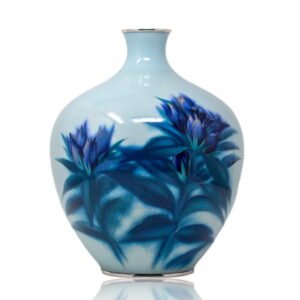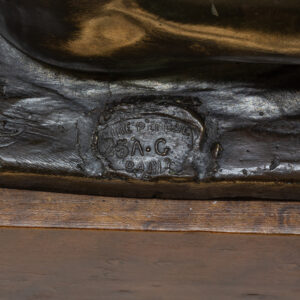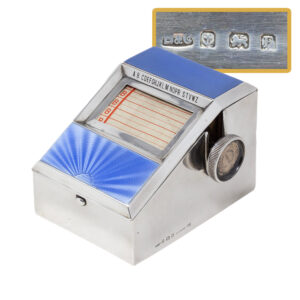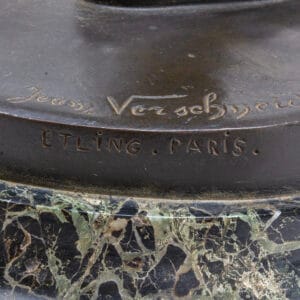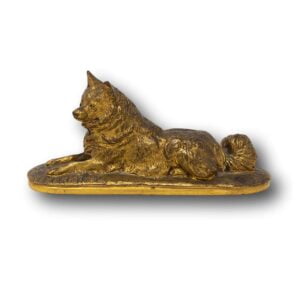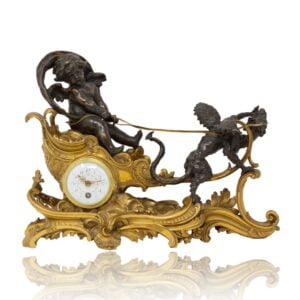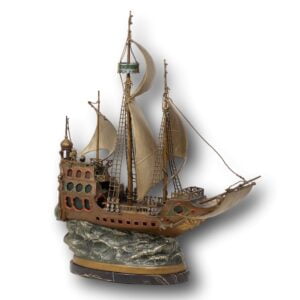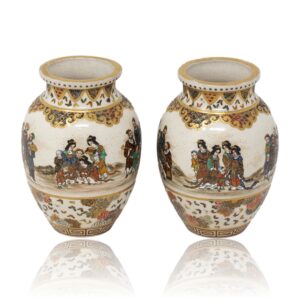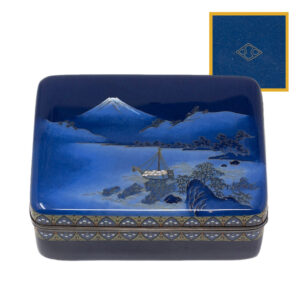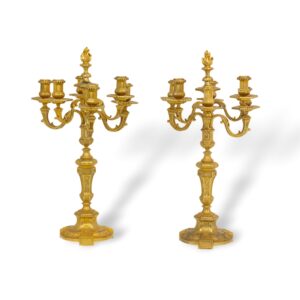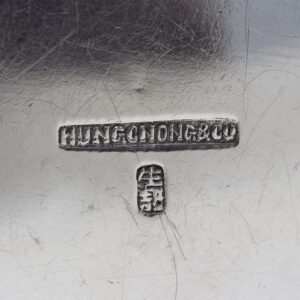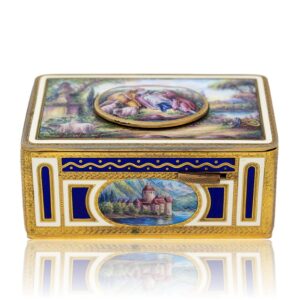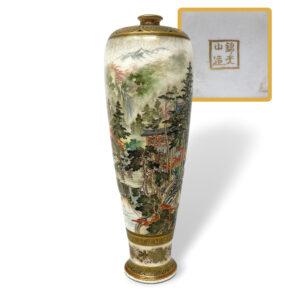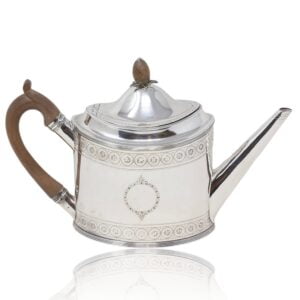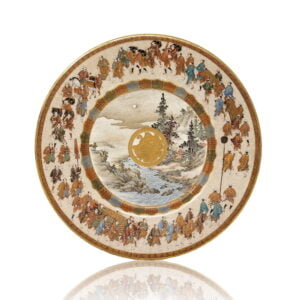Aktien-Gesellschaft Gladenbeck (1851–1926) was one of Germany’s leading bronze foundries, renowned for casting major works such as Walter Schott’s Three Dancing Maidens and the Confederate Memorial in Arlington. Founded in Berlin by Carl Gustav Hermann Gladenbeck, the firm became synonymous with technical excellence in sculpture before closing in 1926.
Makers & Retailers
Alexander James Strachan
Alexander James Strachan (1774–1850) was a leading gold box maker of the late Georgian and Regency periods, often called the “Paul Storr of gold boxes.” Supplying Rundell, Bridge & Rundell and other royal goldsmiths, his work remains a benchmark of early 19th-century luxury craftsmanship.
Alexander Macrae
Alexander Macrae was a 19th-century British silversmith, founder of the firm that became C.J. Vander Ltd. From his Covent Garden workshop he produced fine silver, supplied leading firms such as Elkington and Hunt & Roskell, and laid the foundations for one of London’s most respected silversmithing houses.
Alexandre Kelety
Alexandre Kéléty (1874–1940) was a Hungarian-born sculptor who became a leading figure in French Art Deco. Active in Paris from 1918, he produced bronze, ivory, marble, and ceramic works depicting animals, childhood, dance, and mythological subjects. Exhibited at major Salons and international exhibitions, his pieces were published by Goldscheider and Etling and remain sought after today.
Alfonso Canciani
Alfonso Canciani (1863–1955) was an Italian-Austrian sculptor active in Vienna and Italy. A member of the Viennese Secession and later the Künstlerhaus, he created allegorical, religious, and industrial works, exhibited widely, and won major awards before teaching in Trieste.
Alfred Ivory
Alfred Ivory was a 19th-century London silversmith from a family with deep Clerkenwell roots. Taking over from his mother, Elizabeth, in 1861, he continued the Ivory tradition in the silver trade.
Alfred Lyndhurst Pocock: English Sculptor for Fabergé
Alfred Lyndhurst Pocock (1881–1962) was an English sculptor and the only Englishman known to carve for Fabergé. Recommended by the Royal Academy to Queen Alexandra in 1905, Pocock’s animal models in stone delighted the Queen and began a 13-year collaboration with Fabergé. After the Russian Revolution, Pocock worked independently in London, creating carvings in stone, amber, wood, and other materials. He became a prolific craftsman, admired for both his skill and imagination.
Ando Cloisonne Company
The Ando Cloisonné Company, founded in Nagoya in 1880, became Japan’s leading enamel house. Known for innovations in plique-à-jour and wireless cloisonné, it supplied the Imperial Court and exported worldwide. Today, it remains one of the last surviving cloisonné workshops, with works in major museums and a flagship store in Nagoya.
Antoine-Louis Barye
Antoine-Louis Barye (1795-1875) was a leading French sculptor in the 19th century winning a host of awards and made multiple commissions for the French government.
Antonio Giovanni Lanzirotti
Antonio Giovanni Lanzirotti (1839-1921) was born on the island of Sicily, throughout his career he took commissions from Royalty and exhibited at several world expositions.
Arthur & Bond Japanese Manufactures
Arthur & Bond was an English-owned Yokohama firm dealing in fine silverware and luxury goods, famed for the Liscum Bowl and active until 1923.
Arthur Goldscheider
Arthur Goldscheider was a pioneering French art dealer and publisher of Art Deco bronzes and ceramics. Known for founding the La Stèle and L’Évolution artist groups, he played a crucial role in promoting modern decorative arts at the 1925 Paris Exhibition and worked with leading sculptors of his time.
Asprey of London
Asprey was established in 1781 by William Asprey in central London. Over the years Asprey have manufactured and retailed a consistent high quality shop of personal objects and furniture.
Ball Watch Company
Founded in 1891 by Webster C. Ball, the Ball Watch Company set the standard for railroad timekeeping after the Kipton, Ohio train disaster. Ball’s strict accuracy requirements reshaped American horology, influencing companies like Hamilton, Waltham, and Elgin, as well as Swiss makers including Longines and Vacheron Constantin. Known for precision, reliability, and its ties to the railroad industry, Ball remains one of the most influential names in watchmaking history.
Beddoes & Co
Beddoes & Co, Birmingham silversmiths founded in 1826, crafted fine silver and Art Deco designs. Their hallmark “B & Co” marks sought-after collectible pieces.
Bohuslav Bedřich Josef Schnirch
Bohuslav Bedřich Josef Schnirch (1845–1901) was a Czech sculptor known for his monumental public works in Prague, including the National Theatre, National Museum, and his equestrian statue of George of Poděbrady. His legacy remains central to Czech 19th century art and architecture.
Boin-Taburet
Founded in Paris in 1873, Boin-Taburet became renowned for reviving 18th-century French decorative styles. Awarded a gold medal at the 1889 Exposition Universelle, the firm produced exceptional silver and objets d’art, highly prized by collectors today.
Cartier
Cartier is a French luxury brand founded by Louis-François Cartier (1819–1904) in Paris 1847.
Copenhagen – Royal Porcelain Factory
Royal Copenhagen, officially the Royal Porcelain Factory (Den Kongelige Porcelænsfabrik), is a Danish manufacturer of porcelain products founded in Copenhagen in 1775
Dresden Porcelain
Dresden Porcelain (The Sächsische Porzellan-Manufaktur Dresden GmbH – Saxon Porcelain Manufactory in Dresden Ltd) was founded in 1872 in Freital near Dresden, Germany.
Dunhill
Alfred Dunhill (1872–1959) founded Dunhill after he inherited the family saddlery business on Euston Road, London at the age of 21 developing a line of automobile accessories called “Dunhill’s Motorities”.
Edmond Laurent Etling
Etling Paris, founded by Edmond Laurent Etling in 1909, became a leader in French Art Deco design. Known for pâte de verre glass, bronze, and collaborations with major sculptors, the company produced some of the most recognisable decorative works of the 1920s and 1930s before closing during the Second World War.
Édouard Drouot
Édouard Drouot (1859–1945) was a French sculptor renowned for his dynamic bronze and marble works. Trained under Mathurin Moreau and Émile Thomas, he mastered allegorical, mythological, animalier, and Orientalist subjects, exhibiting at the Paris Salon and earning honors at the Exposition Universelle. His expressive figures and fluid sense of movement secured his reputation as one of the most versatile sculptors of his time.
Edward Barnard and Sons
Edward Barnard and Sons (1680-1977) was a firm of British silversmiths with origins dating back to 1680.
Elkington and Co.
Elkington and Co. was founded by George Richards Elkington and his cousin, Henry Elkington, in the 1830s as G. R. Elkington & Co. operating independently for over one hundred years as Elkington & Co. from 1861 until 1963.
Emile Pinedo
Emile Pinedo was a French sculptor born in 1840, he was known for producing high quality bronzes of mainly figural subjects succeeding his father in 1865 and debuting at the Paris Salon in 1870.
Emmanuel Frémiet
Emmanuel Frémiet was a prominent French sculptor, most famous for his 1874 sculpture of Joan of Arc in Paris, along with similar statues located in Philadelphia and Portland, Oregon, USA. He also created the monument to Ferdinand de Lesseps in Suez.
Erhard and Sohne
Erhard & Sohne was founded in 1844 by Gottlieb Erhard and his two sons in Germany. They made a variety of products including haberdashery, silver and gold plated brass, bronze as well as dolls house accessories and toys. They obtained a world patent for the manufacture of brass inlay in 1904 amassing over 3000 employees across 2 factories in 1900 and in 1945 they turned to specialise in Unimog range of 4-wheel drive utility vehicles and became an important factory for tracked vehicles after WWII.
Ernest Rancoulet
Ernest Rancoulet was a French sculptor from Bordeaux known for his Neoclassical bronzes of mythological, allegorical and figurative subjects. Active during the Belle Époque, his elegant works combined classical tradition with Art Nouveau grace and remain highly prized today.
Eugene Delaplanche
Eugene Delaplanche (1836-1891) was a French sculptor born in Belleville, Paris. He was a pupil of Francisque Joseph Duret.
Ferdinand Barbedienne
Ferdinand Barbedienne (1810-1892) was a celebrated French metalworker most known for his bronze foundry working in partnership with Achille Collas (1795-1859)
Ferdinand Levillain
Ferdinand Levillain (1837-1905) was a French sculptor and medallist renowned for his contributions to decorative arts during the 19th century. His works are characterised by their classical inspiration, often drawing from themes of antiquity, mythology, and allegory. Levillain specialised in creating bas-reliefs, medals, plaques, and other ornamental objects, often collaborating with prominent artisans and manufacturers of his time.
François Linke
François Linke (1855–1946) was a one of the most important and influential Parisian cabinet makers of the late 19th and early 20th centuries.
François-Raoul Larche
François-Raoul Larche (1860-1912) was born in Saint-André-de-Cubzac (North East of Bordeaux) and was known as an Art Nouveau sculptor.
Franz Xavier Bergman
Franz Xavier Bergman (1861-1936) was a world famous sculpture from Venice, Austria known for his erotic and unconventional cold painted bronze sculptures.
Fuji Yoshitoyo
Fujii Yoshitoyo (1868–Unknown) was a pioneering Japanese metalwork artist from Kyoto, celebrated for his damascene innovations, Imperial commissions, and international exhibitions. His rare works reflect both Japan’s long-standing craft traditions and his groundbreaking modern techniques.
Genryusai Seiya
Genryusai Seiya is one of the most celebrated Japanese Bronze artists of the Meiji Period.
George Betjemann & Sons
George Betjemann & Sons were leading London makers of luxury boxes, writing slopes, vanity cases and the famous patented tantalus during the Victorian and Edwardian periods. Their innovative designs, patented mechanisms and fine materials made them highly prized in their own time and remain sought after by collectors today.
Giorgio Sommer
Giorgio Sommer (1834-1914) was born in Frankfurt, Germany and became one of Italy’s most prolific photography studios.
Gyokuzan
Gyokuzan known as Chin Juan was the founding father of the satsuma industry in Kagoshima. His factory produced blanks for decorators such as Yabu Meizan and Gyokushu.
H. Luppens & Cie
H. Luppens & Cie were a famous foundry from Brussels, Belguim operating in the 19th century. The H.Luppens & Cie Foundry had its workshops in Saint-Gilles, 15 rue de Danemark.
Hayashi Kodenji
Hayashi Kodenji I (1831–1915) was a pivotal figure in Japanese cloisonné enamel, known for his role as founder of the Shippo-cho guild and for taking Nagoya enamel to the world stage. Winning international medals and training generations of craftsmen, Kodenji is regarded today as one of the luminaries of Japan’s cloisonné “Golden Age.”
Henry Dasson
Henry Dasson (c. 1825–1896) was a nineteenth century Parisian maker of gilt-bronze mounted furniture.
Hermann Otto Haase-Ilsenburg
Hermann Otto Haase-Ilsenburg (1879–1960) was a German sculptor celebrated for his neoclassical and naturalistic works. His career spanned portrait busts, mythological figures, and monumental commissions, all marked by precision, detail, and expressive form.
Hung Chong & Co.
Hung Chong & Co was one of Shanghai’s most prominent silversmiths, producing Chinese export silver of exceptional quality between the mid-19th and early 20th centuries. Renowned for their detailed repoussé work and elegant designs, the firm blended traditional Chinese motifs with Western influences, making their silverware highly desirable to collectors worldwide.
Imperial Amphora
The Amphora factory was located in Turn-Teplitz, Austria (now in the Czech Republic) was founded in 1892 by Riessner, Stellmacher and Kessel.
Jaeger-LeCoultre
Jager-LeCoultre (known as JLC and Manufacture Jaeger-LeCoultre SA) is a Swiss luxury watch and clock manufacturer founded by Antoine LeCoultre in 1833 and is based in Le Sentier, Switzerland.
James Pittendrigh MacGillivray
James Pittendrigh MacGillivray (1856-1938) referred to as Scotlands greatest sculptor worked and lived in Edinburgh for the majority of his life and career.
Japy Freres
The Japy family are a world renowned French industrial dynasty from Beaucourt in the Territoire de Belfort.
Jenkins & Jenkins
Jenkins & Jenkins were founded in Baltimore, USA as A. Jacobi in 1879. Later succeeded by Jacobi and Jenkins and then Jenkins and Jenkins in 1908-1915.
Joseph Ash I
Joseph Ash I was a London silversmith apprenticed to Roger Biggs of the Glovers Company from 1793. He had two sons, James and Joseph II.
Jules Moigniez
Jules Moigniez (1835–1894) was a renowned French sculptor of the 19th century, celebrated for his intricate bronze depictions of birds, dogs, horses, and hunting scenes. Exhibiting regularly at the Paris Salon, Moigniez gained international acclaim, with more than half of his bronzes sold in Britain. His works, often cast in his father’s foundry using the lost-wax method, remain highly prized for their fine detail and rare patinas.
K. Uyeda Shop (Uyeda Shoten 植田商店)
Founded in 1884, K. Uyeda is one of Japan’s oldest silversmiths, later renowned for cultured pearls and fine jewellery, still operating in Tokyo today.
K.K. Kunstgießerei The Imperial and Royal Art Foundry
The Imperial Art Foundry was a cornerstone of artistic metalwork in 19th century Vienna, producing monumental sculptures and training generations of craftsmen. From bronze statues for the National Theatre to global commissions spanning New York and Sydney, the foundry played a vital role in shaping European sculpture.
Karl Griesbaum
Karl Griesbaum (1872-1941) was founded in 1905 originally producing clock parts. They became the dominant producer of singing bird boxes in the 20th century until they closed in 1988.
Kinkozan Satsuma Company
The Kinkozan family of Kyoto were the most prominent producers of Satsuma ware from the 17th century until 1927. Renowned for their finely crackled glazes, elaborate gold decoration, and detailed scenes of Japanese life and mythology, they became the largest Satsuma workshop and key exporters during the Meiji era. Their works, exhibited worldwide, remain highly prized by collectors today.
Komai Company
The Komai family workshop was opened in 1841 by Komai Seibei who had three sons Komai Yoshitaka, Komai Yoshihiro, and Komai Otojiro.
KPM Königliche Porzellan-Manufaktur
KPM was founded in 1763 by Frederick the Great and known for their high quality porcelain wares which include full tea services to porcelain plaques signed with a sceptre and impressed KMP marks.
Lenzkirch
Lenzkirch (Aktiengesellschaft für Uhrenfabrikation Lenzkirch) was founded in 1851 in the village of Lenzkirch, Baden, South Germany by Eduard Hauser.
Louis Kuppenheim
Louis Kuppenheim (1824-1889) was founded in 1854 together with Heinrich Witzemann, they were located in Pforzheim, southwestern Germany
Mappin & Webb
Mappin & Webb world famous English silversmiths were founded in Sheffield in 1775 by Jonathan Mappin and are still operating today from their flagship London store.
Marcel André Bouraine
Marcel André Bouraine was a leading French Art Deco sculptor, renowned for elegant statuettes, monuments, and decorative works that captured the spirit of the era.
Meissen
Meissen porcelain was the first European hard-paste porcelain. It was founded in the early 18th century and started using its famous cross swords logo from 1731 by official decree.
Miyabe Atsuyoshi 宮部篤良
Miyabe Atsuyoshi (active late 19th-early 20th century) was a Kyoto bronze artist of the Otsuki School, renowned for his inlaid Meiji period works and exhibits at the 1904 St. Louis World’s Fair.
Miyao Eisuke
Miyao Eisuke was a leading Japanese bronze maker of the Meiji period, known for richly gilded okimono, incense burners, and vases. His works, often depicting samurai and mythological figures, gained acclaim at international expositions and remain prized by collectors today.
Musashiya – Ozeki Yahei
The Musashiya Company, was established by Ozeki Yahei and his son Sadajiro rising to prominence in the Meiji Period (1868-1912) manufacturing and dealing in high end silver and decorative objects.
Naruse Seishi
Naruse Seishi (1845-1923) was born in Nakatsugawa City. He began his career as an apprentice potter in 1858 and in circa 1894 moved back to his home town opening a company and workshop named Tohauken.
Nogawa
Nogawa was founded in 1825 at 22 Shijo Otabicho in Kyoto, Japan. They were dealers and manufactures in a range of objects from metalwork to satsuma ware. Their trademark consisted of a circle and diagonal line either inlaid, signed or printed.
Okamoto Ryozan (亮山)
Okamoto Ryozan, born Nakamura Tatsunosuke, was the Head Artist at Kyoto’s Yasuda Company and one of Japan’s most accomplished Satsuma decorators. Trained by Nishimura Zengoro, Ryozan’s Meiji-period works display extraordinary refinement and detail, setting a benchmark in Kyoto ceramic production.
Oskar Theodor Garvens
Oskar Theodor Garvens (1874–1951) was a German sculptor and caricaturist trained in Munich. Known for satirising modernism, he created traditional works often signed with his “o–G” monogram.
Paul Philippe
Paul Philippe (1870-1930) was a renowned early 20th century French-Polish sculptor known for his figures depicting exotic women in various poses composed in bronze, marble and ivory.
Peter & Ann Bateman
Peter & Ann Bateman were the Son and daughter in law of Hester Bateman regarded as the most well known female silversmith in 18th century England. Peter & Ann continued in the family business and passed it onto their kin upon their retirement.
Pierre-Jules Mêne
Pierre-Jules Mêne (1810-1879) was a leading French sculptor in the 19th century and a pioneer in Animalia bronzes.
Prosper LeCourtier
Prosper LeCourtier (1851-1924) was born in Gremilly, North-East France in 1855. He trained under the direction of the highly regarded Animalier sculptor Emmanuel Fremiet where he learned to hone his talents as a sculpture.
Reuge
Reuge was founded by Charles Reuge in 1865 and are regarding to this day as the world leading producer of music automaton.
Robert Edgar Stone
Robert Edgar Stone (1903-1990) was a 20th century silversmith renowned for exceptional hand made commissions throughout the middle of the 20th century.
Royal Worcester
Royal Worcester is an English porcelain company based in Worcester. Founded in 1751 it had several mergers with Flight and Barr, Chamberlain, Grainger and finally Spode.
Saratani Tomizo
Saratani Tomizo (b.1949) was born in Kyoto, Japan. He is regarded as one of the last living master craftsmen of traditional lacquer work.
Seikozan
Seikozan was an exceptional artist located in Kobe Japan’s seventh-largest city working around the Meiji Period (1868-1912).
Sèvres Porcelain (Manufacture nationale de Sèvres)
Sèvres porcelain, founded in 1740 as the Vincennes manufactory, became France’s royal porcelain factory and one of Europe’s leading centres of porcelain production.
Shobido Jewelry Co.
The shobido Jewelry Co. was founded in 1900 by Eikichiro Eto and still operate today offering a selection of high end jewellery and decorative wares.
Tamura
Tamura (Tamura-Shippo) is a Japanese cloisonne company that is located in Shippo-cho, Ama City, Aichi Prefecture. The Tamura company have been producing cloisonne enamel since 1883.
The Inoue Company of Kyoto
The Inoue Company of Kyoto, active from around 1870, was renowned for its bronze and mixed-metal works decorated with gold, silver, and shakudō inlays. Marked with inscriptions such as Kyōto Inoue sei or Inoue zo, their finely crafted vases, dishes, and okimono reflect the innovation of the Meiji period and remain highly prized by collectors today.
The Vienna Porcelain Manufactory
Vienna Porcelain (1718–1864) was produced by the Vienna Porcelain Manufactory, Europe’s second-oldest porcelain factory after Meissen. Founded by Claudius Innocentius Du Paquier and later supported by Empress Maria Theresa, it became renowned for its hard-paste porcelain, richly painted decoration, and distinctive Rococo and Neoclassical designs. Today, pieces from the Du Paquier and Sorgenthal periods are especially prized by collectors and museums worldwide.
Thomas Johnson
Thomas Johnson was an English silversmith working from 10 Dyers Building in Holborn, London. He registered his first mark in January in 1850 and was known for manufacturing every description of dressing case fittings and silver flasks.
Tiffany & Co
Tiffany & Co is an American luxury jewellery and specialty design house headquartered on Fifth Avenue in Manhattan. Tiffany is known for its luxury goods including sterling silver and diamond jewellery.
Tournai Porcelain Belgium
A history of the Belgium porcelain factory Tournai which operated during the 18th-19th century producing porcelain wears similar to Meissen and Sevres.
Unzan
Unzan was a talented Satsuma artist working in the first half of the 20th century through the Meiji Period (1868-1912) to the Tashio period (1912-1926).
Wang Hing
Wang Hing & Co (1854-1941) Wang Hing & Co, based at Zetland House, 10 Queen’s Road, Hong Kong, as well as 1 Sai Hing Street, Canton, and Shanghai, operated from […]
Widdowson & Veale
Widdowson & Veale was located at No. 73 Strand, London, England selling weaponry in the form of swords for the British Army and Navy orders and decorations for the British court and were goldsmiths and jewellers to the court of Spain.
William Comyns
William Comyns established his company circa 1858, eventually incorporating his sons Charles and Richard retailing at The Goldsmiths and Silversmiths Company, Henry Lewis and Howell & James in London as well as Tiffany & Co.
William Hutton and Sons
William Hutton & Sons are one of the most recognised English silversmithing firms of the 19th and early 20th centuries based in Sheffield.
WMF (Württembergische Metallwarenfabrik)
WMF was founded in 1853 by Daniel Straub in Geislingen an der Steige a town in Southern Germany. Originally the firm was named Metallwarenfabrik Straub & Schweizer and was opened as a metal repairing workshop.
Yabu Meizan 藪 明山
Yabu Meizan 藪明山 (1853-1934) was a world renowned Satsuma artist from Nagahori, Osaka. Often regarded as the best in the world during the Meiji Period.
Yasuda Company (Yasuda Kyoto Tojiki Goshikaisha)
Founded in 1896 by brothers Yasuda Gensei and Yasuda Yoshizaburo, the Yasuda Company of Kyoto became one of Japan’s leading producers of fine Satsuma ware and cloisonné during the Meiji period. Working with celebrated artists such as Okamoto Ryozan, Sozan, and Kizan, Yasuda gained a reputation for exceptional craftsmanship and refined design. Today, works bearing the Yasuda name are regarded as benchmarks of Meiji-period artistry and Kyoto ceramic excellence.








